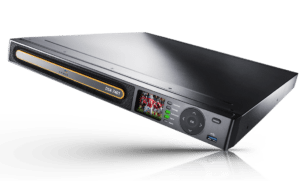Latest News

The Arris DSR-7401 transcoder satellite receiver. Photo: Arris International.
Arris International announced that Starz has selected the Arris DSR-7401 transcoder satellite receiver to derive Standard Definition (SD) programming from High Definition (HD) video programming to reduce satellite network bandwidth while preparing for future content distribution technologies.
According to Starz, the Arris DSR-7401 offers a new level of density and extensibility to modernize delivery of the Starz services to affiliate operators. The DSR-7401 transcoded output is compatible with the vast installed base of MPEG-2 and MPEG-4 SD set-top boxes and can process up to 12 services in a compact single rack unit. The DSR-7401 supports statistical multiplex output, which enables operators to deliver SD services through their existing Quadrature Amplitude Modulation (QAM) networks. The DSR-7401 also includes multi-tuner capability, for simultaneously receiving and processing up to four input satellite transponder multiplexes, for service selection flexibility across networks.
The DSR-7401 supports both High Efficiency Video Coding (HEVC) compression and Digital Video Broadcasting-Satellite-2nd Generation Extension (DVB-S2X) modulation. Both technologies can be used to increase the video capacity of satellite transmission channels, improving existing video service fidelity, or for launching new services such as 4K High Dynamic Range (HDR) programming.
Starz will also deploy Arris’ Broadcast Network Controller 3.8 management system to remotely provision the DSR-7401 Integrated Receiver/Decoders’ (IRD) capabilities across the network — including service selection across four satellite transponders, output Statistical Time Division Multiplexing (StatMUX) configuration, and SD format control.
Get the latest Via Satellite news!
Subscribe Now